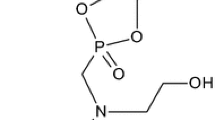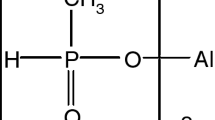Abstract
Flame retardant polyurethane was synthesized via introducing thermally reversible covalent Diels–Alder (DA) adducts into the polyurethane main chain. Firstly, furan-terminated polyurethane prepolymer(PU-Furan) was synthesized from the reaction between isocyanate-terminated prepolymer with or without DOPO-based polyester polyols and furfuryl amine. Secondly, polyurethane with DA adducts (PU-DA) was obtained via Diels–Alder reaction between PU-Furan and commercial 1,1′-(methylenedi-1,4-phenylene) bismaleimide. PU-Furan and PU-DA were characterized by DSC, TGA and 1H NMR, confirming the introduction of the DA adducts into the polyurethane chain. The results of the limiting oxygen index test, Underwriter Laboratory 94 vertical burning (UL-94) test and cone calorimeter test demonstrated that the introduction of the DA adducts improved the flame retardancy of the polyurethane significantly, especially when the polyurethane with flame-retardant element P, due to the synergism flame-resistant effect between flame-retardant element P and thermally reversible DA adducts.









Similar content being viewed by others
References
Zhu C, Lv G (2015) Polyurethane industry status in China and proposal of 13th five-year plan. Polyurethane Ind 30(3):1–25
Wang W (2015) Flame retardant properties of polyurethane-expandable graphite-Aluminium hydroxide Composite:experiments and characterization. China University of Geosciences, Beijing
Mu X, Zhan J, Feng X, Hu Y et al (2017) A novel melamine/o-phthalaldehyde covalent organic frameworks nanaosheets: enhancement flame retardant and mechanical performances of thermoplastic polyurethanes. ACS Appl Mater Interfaces 9(27):23017–23026
Laufer G, Kirkland C, Grunlan JC et al (2013) Exceptionally flame retardant sulfur-based multilayer nanocoating for polyurethane prepared from aqueous polyelectrolyte solutions. ACS Macro Lett 2:361–365
Pan H, Hu Y, Liew KM et al (2015) Formation of layer-by-layer assembled titanate nanotubes filled coating on flexible polyurethane foam with improved flame retardant and smoke suppression properties. ACS Appl Mater Interf 7(1):101–111
East China University of Science and Technology. Synthesis and application of a reactive halogen-free phosphorus-containing flame retardant for polyurethane: China, 103833947. 2014-06-04
Lin F, Lin H, Chen D (2019) Preparation of reactive and additive flame retardant with different oxidation state of phosphorus on the thermal and flammability of thermoplastic polyurethane. Compos Mater 3(2):43–53
Fang Y, Du X, Yang S, Wang H, Cheng X, Du Z (2019) Sustainable and tough polyurethane films with self-healability and flame retardance enabled by reversible chemistry and cyclotriphosphazene. Polym Chem 10(30):4142–4153
Lu S, Hamerton I (2002) recent developments in the chemistry of halogen-free flame retardant polymers. Prog Polym Sci 27:1661–1712
Sun J, Yu Z, Wang X, Wu D (2014) Synthesis and performance of cyclomatrix polyphosphazene derived from trispiro-cyclotriphosphazene as a halogen-free nonflammable material. ACS Sustain Chem Eng 4:231–238
Gu L, Chen G, Yao Y (2014) Two novel phosphorus−nitrogencontaining halogen-free flame retardants of high performance for epoxy resin. Polym Degrad Stab 108:68–75
Yang S, Wang J, Huo S, Wang M, Wang J (2015) Preparation and flame retardancy of a compounded epoxy resin system composed of phosphorus/nitrogen-containing active compounds. Polym Degrad Stab 121:398–406
Liu YF, Chuo TW (2013) Self-healing polymers based on thermally reversible Diels-Alder chemistry. Polym Chem 4:2194–2205
Gandini A (2013) The furan/maleimide Diels-Alder reaction: a versatile click–unclick tool in macromolecular synthesis. Prog Polym Sci 38(1):1–29
Zhang YC, Broekhuis AA, Picchioni F (2009) Thermally self-healing polymeric materials: the next step to recycling thermoset polymers. Macromolecules 42:1906–1912
Chen X, Dam MA, Ono K, Mal A, Shen H, Nutt SR, Sheran K, Wudl F (2002) A thermally re-mendable cross-linked polymeric material. Science 295(5560):1698–1702
Tian Q, Yuan YC, Rong MZ, Zhang MQ (2009) A thermally remendable epoxy resin. J Mater Chem 19(9):1289–1296
Yu S, Zhang R, Sun P (2013) Bio-inspired high-performance and recyclable crosslinked polymers. Adv Mater 25(35):4912–4917
Yang K, Grant JC, Lamey P, Smaldone RA et al (2017) Diels–Alder reversible thermoset 3D printing: isotropic thermoset polymers via fused filament fabrication. Adv Funct Mater 27(24):1700318–1700329
Wu M, Liu Y, Du P, Wang X et al (2020) Polyurethane hot melt adhesive based on Diels–Alder reaction. Int J Adhes Adhes 100:102597–102600
Du X, Jin L, Deng S, Zhou M, Du Z, Cheng X, Wang H (2021) Recyclable, self-healing, and flame-retardant solid–solid phase change materials based on thermally reversible cross-links for sustainable thermal energy storage. ACS Appl Mater Interfaces 13(36):42991–43001
Du P, Liu X, Wang X et al (2013) Synthesis and characterization of linear self-healing polyurethane based on thermally reversible Diels–Alder reaction. RSC Adv 3:15475–15482
Ma C, Yu B, Hong N, Pan Y, Hu W, Hu Y (2016) Facile synthesis of a highly effiffifficient, halogen-free, and intumescent flame retardant for epoxy resins: thermal properties, combustion behaviors, and flame-retardant mechanisms. Ind Eng Chem Res 55:10868–10879
Acknowledgements
This work was supported by National Natural Science Foundation of China (Granted No. 201805035). This project is also supported by the Science and Technology Development Projects of the Central Committee Guidance Local (No. 2018L3015). This is supported by the Natural Science Foundation Guidance Projects of Fujian Province (No. 2021Y0010).
Author information
Authors and Affiliations
Corresponding author
Additional information
Publisher's Note
Springer Nature remains neutral with regard to jurisdictional claims in published maps and institutional affiliations.
Supplementary Information
Below is the link to the electronic supplementary material.
Rights and permissions
About this article
Cite this article
Cai, M., Tian, Z., Cui, L. et al. Flame retardancy of linear polyurethane with Diels–Alder adducts. Polym. Bull. 80, 4195–4207 (2023). https://doi.org/10.1007/s00289-022-04229-8
Received:
Revised:
Accepted:
Published:
Issue Date:
DOI: https://doi.org/10.1007/s00289-022-04229-8




